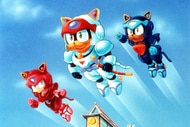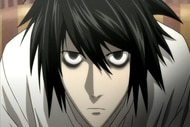Create a free profile to get unlimited access to exclusive videos, sweepstakes, and more!
The Digimon reboot is fixing one of Pokémon's biggest problems

Fans argued about whether Star Wars or Star Trek was better a generation ago, and the Marvel vs. DC war doesn't seem to have an end in sight, but '90s kids grew up having to choose sides in the great 'mon franchise war. We are talking, of course, about Digimon and Pokémon — with similar titles, origin stories, and merchandise that confused more than one parent while trying to buy the right present for their kid.
Though the franchises are actually very different, both — especially Pokémon — had one common criticism: that they were basically about dogfighting. In Pokémon, trainers as young as 10 go out into the world, capture innocent wild animals, and then force them to fight other wild animals for sport. The kids simply shout out commands, and their monster companion/pet goes up and beats the other until defeat (a KO in Pokémon, or death in the case of Digimon). But the new Digimon Adventure: 2020 reboot is fixing that problem by having the kids fight alongside their "Digipartners."
In the reboot — which retells the story of the original Digimon: Adventure but adds in some mythology from later seasons, an expanded role for technology, and noticeably better animation — whenever a Digimon evolves for a fight, we see their human partner riding a Digimon into battle. Koshiro, the smart one in the group of DigiDestined, is often talking to his Digimon, coming out with plans and strategies in the middle of the fight. It helps that the evolved Digimon are Godzilla-sized behemoths that can easily carry a small child on their backs. In Episode 8, the DigiDestined raid a Digimon fortress with their Digipartners, and during the fight we see the kids acting as bait in order to let their Digimon to charge forward unopposed.
This dynamic allows the series to shine a light on the teamwork between humans and Digimon, and how that helps them to succeed. The kids in the original show were mostly just an audience reacting to the fight, but here they are active participants. Sure, the kids can't exactly shoot fire out of their mouths, or fly, or fight in any way, but that doesn't stop them from trying to help out their Digipartners. The kids get hurt alongside their Digimon, are as excited to be winning as the Digimon, and generally act as if they're a team and not just a master and their pet.
Another big change that the reboot adds from later seasons of Digimon is in how dangerous its titular digital monsters are. Unlike Pokémon, the original Digimon: Adventure made fighting almost always a matter of survival, rather than Pokémon's sport. But in the Digimon Tamers series, the Digimons' primitive nature is brought centerfold, where the show leans into the idea that the Digimon look like they are built for fighting and they might even enjoy doing so. In the reboot, Greymon builds a sort of rivalry with Orgemon, a villain who starts seeking the kids when ordered to by an evil Digimon, but it's remarked upon by other characters that he actually enjoys fighting Greymon because he actually poses a challenge. Pokémon has sometimes explored this idea, but it's usually in the context of Pokémon enjoying winning battles with their trainers, not necessarily something that happens in nature.
By having the Digimon talk and interact with their human partners, the reboot series manages to do character development at the same time as it does cool action scenes. In the original, the relationships between the Digimon and the human kids was of big importance, but for the most part, the Digimon stayed silent while fighting, and most of the character growth came in the quieter scenes wherein characters simply sat down and talked. Though the kids have different personalities, backgrounds, and motivations, pretty much every Digimon not named Agumon is exactly the same as the other. In the reboot, however, the Digimon actually talk while fighting; we see how they think, and they even change personalities when they evolve. Tentomon, who is as big a shy, quiet nerd as Koshiro, becomes a jacked, confident go-getter once he evolves from his child (or "rookie") form into Kabuterimon, his adult (or "champion") form.
The Digimon now have personalities beyond their interactions with their human partners, being treated as characters in their own right. The reboot even puts a bigger emphasis on the relationship and the banter that the Digimon have with each other. In Episode 8, after being separated for most of the season so far, Agumon and Gabumon are reunited, and they seem incredibly excited to see each other and act like longtime friends. In that same episode, Palmon saves both her partner, Mimi, and Joe, and then spends much of the episode acting as she's the only responsible adult capable of taking care of every other Digimon and kid. Likewise, where evolution was previously just a superpower used in fights, the reboot also has the Digimon evolve outside of combat in order to cross long distances or solve problems that they can't simply solve as tiny Digimon, giving the feeling that their evolved forms are extensions of themselves rather than a battle form.
Pokémon and Digimon have always been competitor franchises due to their surface-level similarities, but the shows have mostly been as separate as you could imagine. Now, with the new reboot, Digimon is outright fixing Pokémon's biggest flaw. Both shows are supposed to be about kids and their relationship with monsters, but only one treats that relationship as an equal partnership rather than as a master and his pet.


























